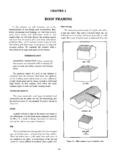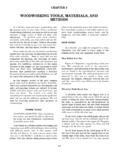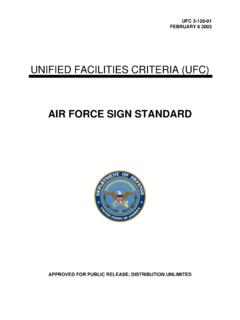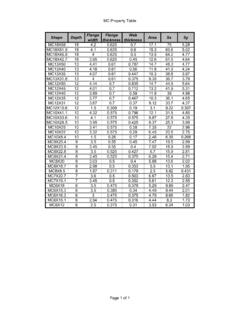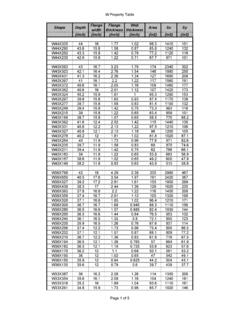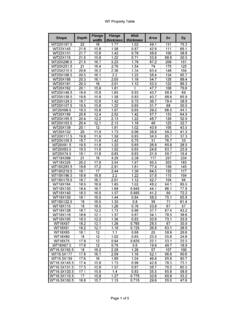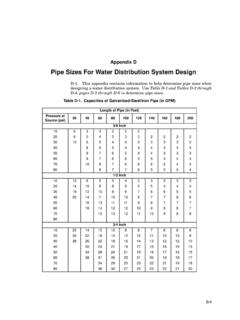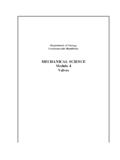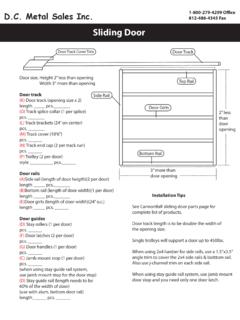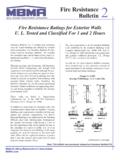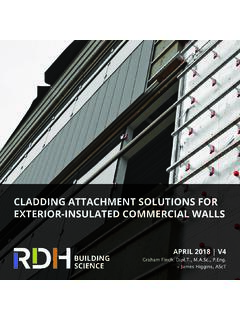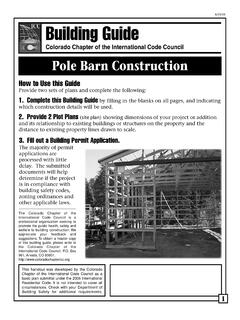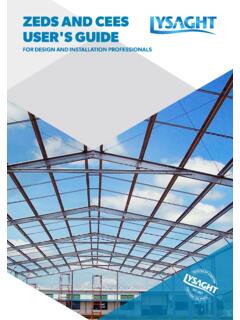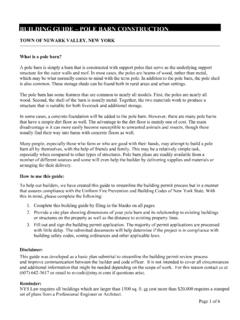Transcription of TYPES OF FRAMING - Construction Knowledge.net
1 After the foundation is built and the batter boards are removed, the carpenter builds the framework. The framework consists of beams, trusses, walls and partitions, flooring, ceilings, sheathing and siding, stairways, roof FRAMING and coverings (Chapter 7), and doors and windows (Chapter 8). This chapter familiarizes the carpenter with materials, tools, and techniques used to build the framework. TYPES OF FRAMING . FRAMING consists of light, heavy, and expedient FRAMING . LIGHT FRAMING . There are three principal TYPES of FRAMING for light structures: western, balloon, and braced. Figure 6-1, page 6-2, illustrates these TYPES of FRAMING and specifies the nomenclature and location of the various members. Light FRAMING is used in barracks, bathhouses, and administration buildings. Figure 6-2, page 6-3, shows some details of a 20-foot wide building (such as ground level, window openings, braces, and splices) and labels the FRAMING parts.
2 Much of light FRAMING can be done in staging areas while staking out, squaring, and floor FRAMING is being done. Subflooring can begin when a portion of the floor joists has been laid. The better-skilled men should construct the frame, and with good coordination, a large force of men can be kept busy during FRAMING . Western Frame The western or platform frame (Figure 6-1, 1) is used extensively in military Construction . It is similar to the braced frame, but has boxed-sill Construction at each floor line. Also note that cross bridging is used between the joists and bridging is used between the studs. The platform frame is preferred for one-story structures since it permits both the bearing and nonbearing walls (which are supported by the joist) to settle uniformly. Balloon Frame The balloon frame (Figure 6-1, 2) is a widely used type of light FRAMING . The major difference between balloon and braced FRAMING in a multistory building is that in balloon FRAMING the studs run the full length, from sill to rafters.
3 It is customary for second-floor joists to rest on a 1- x 4-inch ribbon that has been set into the studs. The balloon frame is less rigid than a braced frame. Braced Frame A braced frame (Figure 6-1, 3) is much more rigid than a balloon frame. Exterior studs extend only between floors and are topped by girts that form a sill for the joists of the succeeding floor. Girts are usually 4 x 6 inches. With the exception of studs, braced frame members are heavier than those in balloon FRAMING . Sills and corner posts are customarily 4 x 6 inches. Unlike the studs, corner posts extend from sill to plate. Knee braces, usually 2 x 4 inches, are placed diagonally against each side of the corner posts. Interior studding for braced frames is the same as for balloon-frame Construction . HEAVY FRAMING . Heavy-frame buildings are more permanent, and are normally used for warehouses and shops.
4 Heavy FRAMING is seldom used in TO Construction . Figure 6-3, page 6-4, shows the details of heavy FRAMING . Heavy FRAMING consists of FRAMING members at least 6 inches in dimension (timber Construction ). Long, unsupported areas between walls are spanned by built-up roof trusses. EXPEDIENT FRAMING . Some field conditions require expedient FRAMING techniques. For example . Light siding. Chicken wire and water-resistant bituminous paper can be sandwiched to provide adequate temporary FRAMING in temperate climates. Salvaged FRAMING . Salvaged sheet metal, such as corrugated material or gasoline cans, can be used as siding in the Construction of emergency housing. Local timber. Poles trimmed from saplings or bamboo can be constructed into reasonably sound FRAMING and may be secured with native vines if necessary. Wood-substitute FRAMING . Adobe (soil, straw, and water mixed until spreadable) can be used to form walls, floors, and foundations.
5 A similar mixture may be used to form sun- dried bricks. Excavations. Proper excavation and simple log cribbing may also be covered with sod and carefully drained to give adequate shelter. CONNECTIONS. Weak points in a structure usually occur at the connections (joints and splices) between pieces of lumber. However, these connections can be structurally sound if done correctly. Such weak points are usually a sign of poor workmanship. JOINTS. Joints are connections between two pieces of timber that come together at an angle. The TYPES of joints most commonly used in carpentry are butt joints and lap joints. Butt Joints A butt joint is formed by placing the end of one board against another board so that the boards are at an angle (usually a right angle), forming a corner. The TYPES of butt joints are shown in Figure 6-4 and are described below. Straight Butt Joint. This joint is formed by placing the square-cut end of one board against the square face of another.
6 The butt end of one board should be square and the face of the other board smooth so that they fit perpendicular to each other. Select the right type of nails or screws to hold such a joint securely. For FRAMING , butt joints are secured by 8d or 10d nails that are toenailed to strengthen the joint. The end grain is the weakest part of a piece of wood when used in joints. A butt joint is made at either one or two end- grain parts. It will be no stronger than the quality of those parts. A butt joint is, therefore, the weakest type of joint. This is especially true if the joint is made of two pieces of wood only. Oblique Butt Joint. This joint is formed by butting the mitered end of one board against the face of another board. Bracing is typically made with this joint. It should not be used where great strength is required. The strength of the oblique butt joint depends upon the nailing.
7 The nail size depends upon the timber size. Nails should be toenailed to strengthen the joint; not too many nails should be used. Miter Butt Joint. This joint is formed by bringing the mitered ends of two boards together to form the desired angle. This joint is normally used at corners where a straight butt joint would not be satisfactory. To form a right-angle miter joint (the most commonly used), cut each piece at a 45 angle so that when the pieces are joined they will form a 90 angle. The miter joint is used mostly in FRAMING . However, it is a very weak joint and should not be used where strength is important. Lap Joints The lap joint is the strongest joint. Lap joints (Figure 6-5). are formed in one of two ways: a plain lap joint or a half-lap splice joint. Plain Lap Joint. This joint is formed by laying one board over another and fastening the two with screws or nails.
8 This is the simplest and most often used method of joining. This joint is as strong as the fasteners and material used. Half-Lap Splice Joint. This joint is formed by cutting away equal-length portions (usually half) from the thickness of two boards. The two are then joined so that they overlap and form a corner. Overlapping surfaces must fit snugly and smoothly. Overlaps should be sawed on the waste side of the gauge line, to avoid cutting laps oversize by the thickness of the cut. This joint is relatively strong and easy to make. NOTE: Some useful variations of the half-lap joint are the cross-lap, the middle-lap, and the mitered half-lap joints. SPLICES. Splices connect two or more pieces of material that extend in the same line. The joint will be as strong as the unjoined portions. The type of splice used depends on the type of stress and strain that the spliced timber must withstand.
9 Vertical supports (longitudinal stress) require splices that resist compression. Trusses, braces, and joists (transverse and angular stress) require splices that resist tension. Horizontal supports, such as girders or beams, require splices that resist bending tension and compression. For example, splices for resisting compression are usually worthless for resisting tension or bending. Figure 6-6 shows splice TYPES ;. Figure 6-7 shows splice stresses. Compression-Resistant Splices. Compression-resistant splices support weight or exert pressure and will resist compression stress only. The most common TYPES of compression- Figure 6-7. Splice stresses resistant splices are the butt splice and the halved splice. Butt Splice. This splice is constructed by butting the squared ends of two pieces of timber together and securing them in this position with two wood or metal pieces fastened on opposite sides of the timber.
10 The two short supporting pieces keep the splice straight and prevent buckling. Metal plates used as supports in a butt splice are called fishplates. Wood plates are called scabs and are fastened in place with bolts or screws. Bolts, nails, or corrugated fasteners may be used to secure scabs. If nails are used with scabs, they are staggered and driven at an angle away from the splice. Too many nails, or nails that are too large, will weaken a splice. Halved Splice. This splice is made by cutting away half the thickness of equal lengths from the ends of two pieces of timber, then fitting the tongues (laps) together. The laps should be long enough to provide adequate bearing surfaces. Nails or bolts may be used to fasten the halved splice. Note: To give the halved splice resistance to tension as well as compression, fishplates or scabs may be used. Tension-Resistant Splices In members such as trusses, braces, and joists, the joint undergoes stress in more than one direction; this creates tension, buckling the member in a predictable direction.
